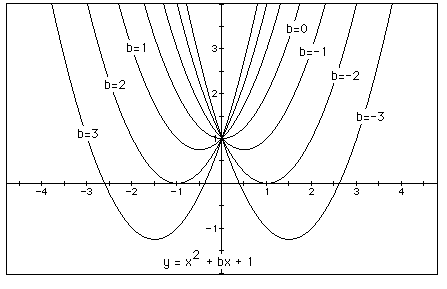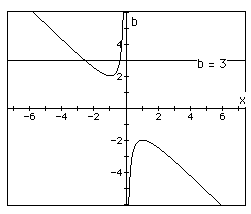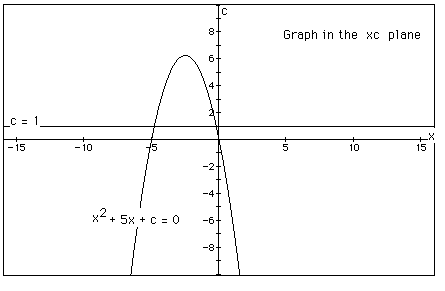and to overlay several graphs of
for different values of a, b, or c as the other two are held constant.
From these graphs discussion of the patterns for the roots of
can be followed. For example, if we set
for b = -3, -2, -1, 0, 1, 2, 3, and overlay the graphs, the following
picture is obtained.

We can discuss the "movement" of a parabola as b is
changed. The parabola always passes through the same point on the y-axis,
the point (0,1) with this equation). For b < -2 the parabola will intersect
the x-axis in two points with positive x value; that is, the original equation
will have two real roots, both positive. For b = -2, the parabola is tangent
to the x-axis and so the original equation has one real root at the point
of tangency. It is positive. For -2 < b < 2, the parabola does not
intersect the x-axis. That means the original equation has no real roots.
Similarly for b = 2 the parabola is tangent to the x-axis and has one real
negative root. For b > 2, the parabola intersets the x-axis twice to
show two negative real roots for each b.
Now x is one variable and b is the second variable
with y fixed at zero. Now graph this relation in the xb plane.
We get the following graph.

If we take any particular value of b, say b = 3, and overlay this equation
on the graph we add a line parallel to the x-axis. If it intersects the
curve in the xb plane the intersection points correspond to the roots of
the original equation for that value of b. We have the following graph.

For each value of b we select, we get a horizontal line. It is clear
on a single graph that we get two negative real roots of the original equation
when b > 2, one negative real root when b = 2, no real roots for -2 <
b < 2, one positive real root when b = -2, and two positive real roots
when b < -2.
This seems easier to see when graphed in the xb plane.
Let's see what happens when we graph

Notice that the intersections of this equation are coincident with those
from the previous two equations.
Consider the case when c = - 1 rather than + 1.

Now we have hyperbolas opening in the opposite direction.
is considered. If the equation is graphed in the xc plane, it is easy
to see that the curve will be a parabola. For each value of c considered,
its graph will be a line crossing the parabola in 0, 1, or 2 points. The
intersections will be at the roots of the original equation at that value
of c. Below the graph of c = 1 is shown. The equation
will have two negative roots -- approximately -0.2 and -4.8.

There is one value of c where the equation will have only 1 real root
-- at c = 6.25. For c > 6.25 the equation will have no real roots and
for c < 6.25 the equation will have two roots, both negative for 0 <
c < 6.25, one negative and one 0 when c = 0 and one negative and one
positive when c < 0.
Again for each value of c selected, there is a horizontal line and it will
be easy to see how many roots there are and whether or not they are real.
Let's see what happens if this graph is overlaid with
one in which b is replaced with -b.

That merely shifts the graph to the left. What if the c is replaced with
a -c?

That's simply inverts the graph. It seems that one can easily read the
roots of the equation by graphing each desired value for c. This is similar
to the situation in the xb plane.

